Introduction
Ducky has long been one of the most used and loved niche keyboard manufacturers thanks to their attention to detail and focus on performance and feel. With custom mechanical keyboards becoming more and more popular every single week, we also see a rising demand for features that are considered to be normal in the enthusiast scene to be brought to mass-produced keyboards. If you want to stand out in the keyboard space these days it’s not enough to have fancy switches or an LCD screen on the case: you’ll (also) need good stabilizers and solid (preferably PBT) keycaps, for example, and even things like a hotswap PCB are becoming more and more of a demand these days.
A gaming keyboard not only needs to be a good performer, but it also has to feel and sound great in order to stand out. Companies have been bringing updates and features to the mass-produced market in an effort to produce the best stock keyboard out there, and that’s to the benefit of consumers. With companies knowing that consumers are becoming more and more up to date on what constitutes a good keyboard, the overall quality of mass-produced boards is rising while the prices are staying relatively stable.
Today, we’re taking a look at Ducky’s entry in this relatively new ‘race to the keyboard top’. The One 3 Mini builds on their most famous and well-known model, the One 2 Mini, and comes with a bunch of improvements, including a hotswap PCB, improved (lubed) stabilizers, and noise dampening foam for that optimal acoustic experience.
Is the Ducky One 3 Mini worth it in today’s market, or has the One line lost its charm? Find out everything you need to know in our full Ducky One 3 Mini review!
At A Glance
Ducky One 3 Mini
Used by 1 player ()The One 3 Mini is a fantastic keyboard, complete with nice (lubed) stabilizers, noise dampening foam, a hotswap PCB, and PBT keycaps. In a nutshell: everything that you’d want out of a mass-produced keyboard (even as a keyboard aficionado) is here and it’s executed well. On its own, the One 3 Mini delivers an experience that easily rivals (and beats) most of its competitors in its price category, and with minimal investments and/or a tiny bit of tinkering you can get it to feel and sound like a board that’s much more expensive than what it actually costs.
Pros
- Nicely lubed stabilizers
- Noise dampening foam included
- Great PBT keycaps
- Brings hotswap to 60% Ducky keyboard
- Great typing experience
- Easy to mod and open up
Cons
- No software for people who want to configure in-depth lighting profiles or macros
- Key registering/latency issues on certain firmware versions
Specs
| Form Factor | 60% |
|---|---|
| Switches | Cherry MX Black, Cherry MX Brown, Cherry MX Blue, Cherry MX Red, Cherry MX Silver, Cherry MX Clear, Cherry MX Silent Red |
| PCB | Hotswappable |
| RGB | Yes |
| Height | 3.9cm |
| Width | 30.7cm |
| Length | 10.6cm |
| Weight | 639g |
First Impressions
What’s immediately obvious with the One 3 Mini is the fact that Ducky have done away with the standard black design that I saw on the One 2 Mini that I reviewed. The colorway that I received is called ‘DayBreak’ and it’s, as you can see, a mix between blue, grey and a sort of yellow-green neon mixture. Despite the fact that I prefer a minimal aesthetic for my work desk (my gaming space often looks like the Las Vegas strip by comparison) I find keyboards that are completely black to be a bit boring, and I find this to be just the right amount of striking without going overboard and looking gaudy, but of course that’s very subjective. I rather like the look of this board, but that’s also because it uses colors that I like.
What’s nice is that there’s a minimal amount of branding. There’s the Ducky logo on the front portion of the spacebar, but other than that you won’t notice any branding when viewing the board from the top.
The case is spray painted with a sort of metallic-looking finish, but it’s still a completely plastic build. That doesn’t have to be a negative, but if you’re looking for a Ducky with a metal/aluminum case with these features you’ll have to wait for an SF version.
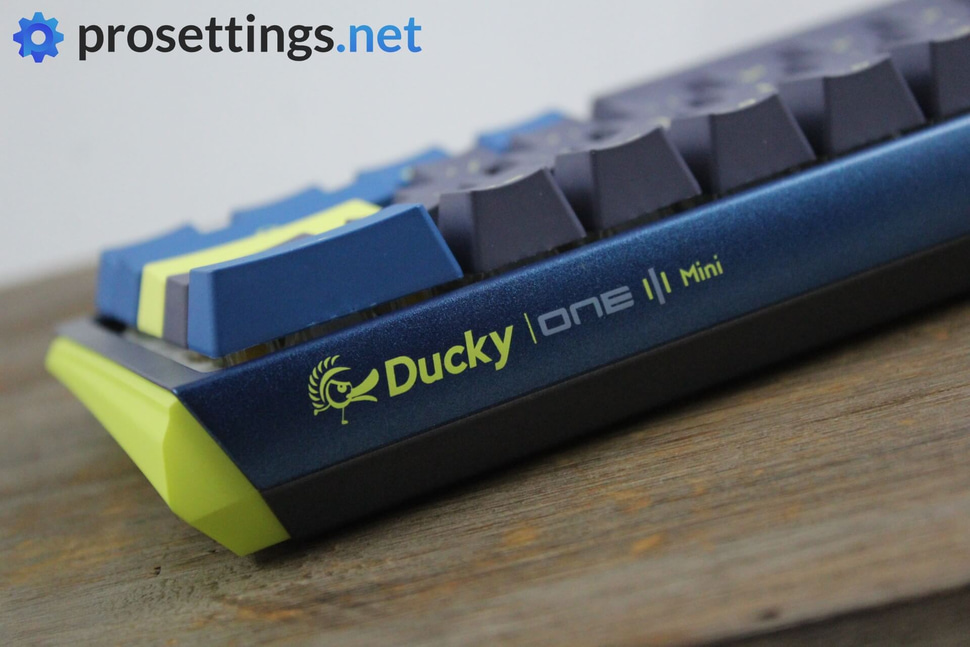
The fact that it’s made of plastic is excusable if you look at what you’re getting for the price that Ducky is asking for, and also because it doesn’t feel super cheap or anything like that. It does flex a little bit when I hold it in both hands and apply pressure, but there’s absolutely no creaking or flexing when I’m using it in a regular way where it’s just sitting on my desk/deskpad so I have no complaints about the build quality of the One 3 Mini.
As I’ve come to expect from Ducky the RGB is also fantastic. There’s a white backplate here, and that really allows the colors to bounce off of it nicely. One thing to note is that the keycaps are not shine through this time around, leading to an overall less impressive RGB show when compared to caps that do allow light to shine through their legends. The board uses a standard bottom row though, so swapping out these caps should be a breeze if you’re looking for more on the RGB front. I myself quite like the fact that they’ve gone for solid legends as opposed to shine through legends as I usually don’t turn on RGB effects unless I’m going to be gaming for the night, so I vastly prefer solid caps as those simply look better with the RGB turned off.
Packaging
Ducky is a company that always includes a bunch of lovely little extras with their keyboards, and that’s no different here. You get a bunch of Ducky stickers, the usual documentation, a nice keycap puller, a switch puller, a braided USB-C cable, a plastic dust cover, and a set of extra keycaps that allow you to customize the board to some degree so that you can really make it your own. These additional caps aren’t an afterthought either: they’re PBT, just like the caps that are on the board. That’s a nice touch since some companies use inferior materials for their extra caps.
The cable that’s included is now braided as opposed to just bare plastic like what we saw on earlier Ducky boards. It’s not a super premium cable (but that can’t be expected from a keyboard at this price point) but it is an upgrade over the earlier cables that Ducky used if you ask me.
In a nutshell: other companies can learn from the unboxing experience that Ducky offers. This is certainly not a budget keyboard, but its MSRP is lower than what some other brands are asking for their premium boards, and I very rarely (if ever) see all of these extras included with those.
Features and Build
The Ducky One 3 Mini is a 60% board, but there is also the TKL version, a 65% version (called ‘SF’), and a full sized version, so there is something available for everyone. Personally, I’m more of a fan of 65% boards. I just can’t live without the arrow keys for productivity and general day-to-day usage, but that of course won’t influence my opinion on this keyboard, doubly so because there are larger versions available for those who prefer that. In case you’re not completely familiar with these smaller boards: you can still access the arrow key functionality (and the F row and what not) with the One 3 Mini, you just have to do it by pressing a combination of the Fn key along with the corresponding key.
Speaking of arrow keys: I’m glad to notice that Ducky has moved the arrow keys to be on the ,./ and l buttons instead of on jkli where they previously were. This feels a bit more natural to use with one hand, which is one of the main reasons I prefer 65% boards.
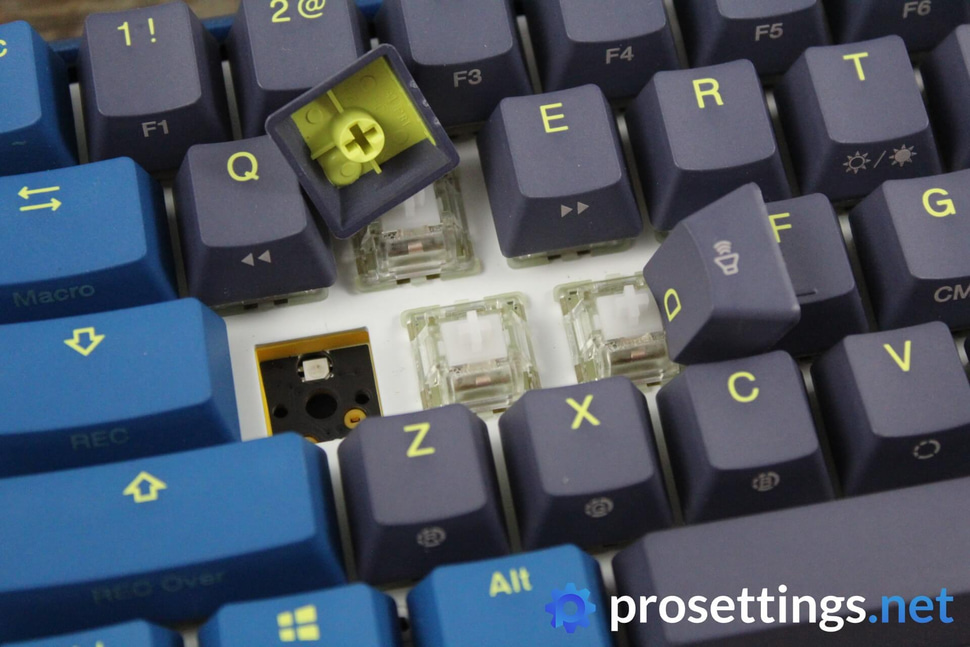
The keycaps, as has been the case with Ducky since I started reviewing their boards, are made of PBT. That’s a material that’s a lot more durable than the thin ABS caps that are commonly found on mass-produced boards, and PBT caps don’t develop a shine nearly as quickly as ABS ones do. These caps are every so slightly textured for extra grip and the legends and colors on them look crisp and clean. I’m very pleased with these keycaps.
Under the hood is where we see the biggest changes. Inside the case there’s now a (thin) layer of foam to reduce case ping and to help with the case feeling less hollow, and between the PCB and top plate there’s a thick pad that aims to do the same. The foam pad between the plate and PCB is thick and looks excellent, though the foam layer on the bottom of the case could be a bit thicker in my opinion. That’s a small nitpick (most manufacturers don’t even think about adding noise dampening foam) but it’s something that I noted regardless.
On the bottom of the case you will find four thin rubber feet that do their job perfectly: the One 3 Mini does not move when gaming or typing at all. Two sets of flip feet allow you to customize the typing angle, and while I personally prefer the flattest angle it’s always good to have options.
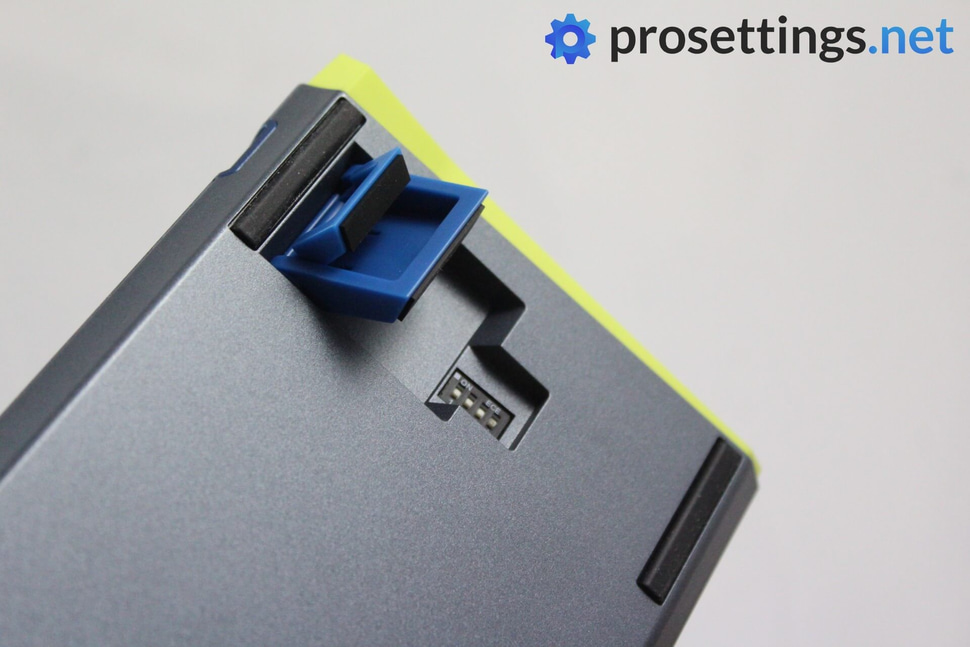
Something that I also appreciate is that Ducky has left room on the case for custom cables. Using pretty coiled/customized cable is something that a lot of mechanical keyboard enthusiasts like to do and despite the fact that the USB-C connector is recessed there is plenty of room around it to allow custom cables to connect to the board.
Finally, the case now has more ‘flair’ to it on the sides. Whereas the One 2 was mostly flat on the sides there’s now a bit of a curving element that’s been added to the side. I don’t know if I’m a big fan of this but it does help the product ‘pop’ a bit more and it never gets in the way nor does it look too attention-grabbing so all in all it’s a change that probably won’t offend anyone.
Performance and Everyday Usage
Update April 15th, 2022: after my testing period I started noticing that sometimes keys would not register when holding multiple ones at the same time (e.g. when strafing). I contacted Ducky about this and they said they would investigate the issue and, if widespread, fix it via firmware (found here by going to your specific model). That worked, but the newest version of the firmware (1.09) reintroduces the problem. Ducky’s reps have said they are working on the situation.
Something that I noticed is that Ducky, as of right now, doesn’t seem to be selling the One 3 in a barebones (without any switches installed) edition. That’s not a huge issue of course, but if you already know you’re going to be using anything other than Cherry MX switches with this board (or you have a set of lubed Cherries that you’d like to use) it’s kind of a pity to pay a bit extra for switches you’ll never use. That said: I know that Ducky doesn’t exactly focus on hardcore keyboard enthusiasts so most people probably will get this board with switches installed and then switch it up afterwards should they get tired of their current ones.
Speaking of switches: the board that I got for review has Cherry MX Clears installed in it and, to put it mildly, I don’t like them. That’s not Ducky’s fault of course, but I used these switches for a couple of hours, recorded a sound test, and chucked them out as soon as I found a bit of time because they felt very scratchy and sounded pingy to me. I don’t have an issue with tactile switches (some of my favorite self-built boards have switches with a rather substantial tactile bump to them installed) but these absolutely weren’t it for me.
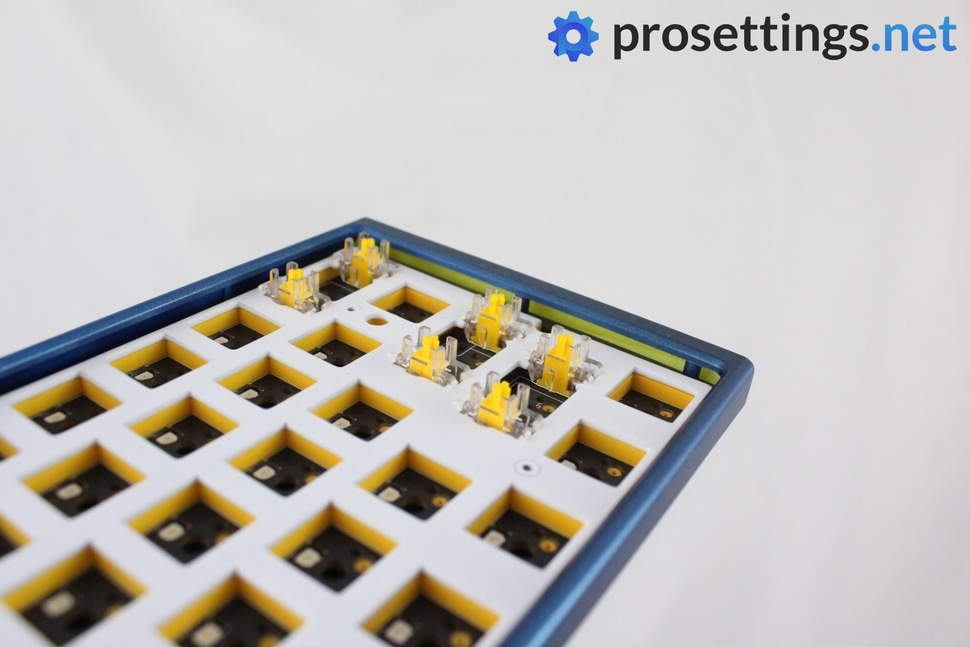
The point of a hotswap board is that you can switch out annoying switches in an instant, though. You don’t need to have any prior or technical knowledge to do this. Simply use the included switch puller, pull the switch, and install a new one. You can do this even if you don’t care about keyboards or don’t have any other tools (other than other switches, of course) at your disposal so the feeling of these Cherry Clear switches isn’t really something that I take into consideration as far as my opinion on this board goes.
What I do take into consideration are things that aren’t so easily changed if you don’t have any prior experience or tools. Components such as stabilizers and the aforementioned foam can do a great deal to influence the overall acoustic experience with a keyboard, and if you’re someone who just wants to buy a nice keyboard and, at most, replace the switches, you’re not likely to be opening up the stabs, for example. Luckily these perform great. There’s a bit of factory lube on them but, as is usually the case with factory lubed stabs on mass-produced boards, there isn’t a lot of it. That said: the stock stabilizers sounds extremely decent and are among the better ones I’ve used so far.
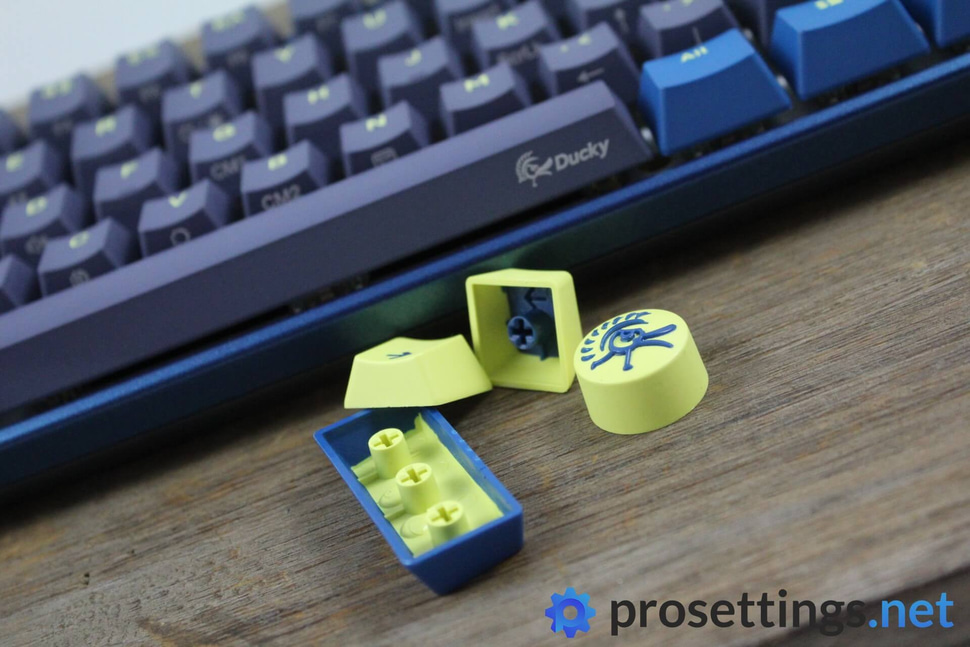
The foam also seems to be doing its job. Whereas the Ducky One 2 Mini could sound a bit hollow (that’s not a knock on that board; it was released at a time where the keyboard scene was very much in its infancy compared to where it is now) this is not the case anymore with the One 3 Mini.
Something that I am missing here is some software. I dislike it when you have to download software before a product becomes usable, but certainly with something like a keyboard (where programming a pleasing RGB scene is something that is done by a lot of people) it can be handy to have some optional software for those times where you want to edit complex macros or program an intricate lighting scheme. Back when I reviewed the One 2 SF, Ducky told me they were working on software, but that sadly hasn’t been released just yet. You can do almost everything you’d want on the board itself, but there naturally is a large learning curve to something like that so I think that a lightweight and basic piece of software could really elevate the overall product.
One last thing that I noticed is how easy it is to take the One 3 Mini apart. There are only a couple of screws on the top plate that you need to remove in order to get the plate assembly out of the case, meaning that it’s extremely easy to, for example, add your own foam or something like that. If you’re someone who likes to tinker with their keyboards or you want to start modding mechanical keyboards then the One 3 Mini can be, in huge part thanks to the hotswap PCB, a great starting point.

In the interest of seeing how far I could drive things from the POV of a keyboard beginner (I wouldn’t consider myself advanced on this front but I do have various tools and stuff like lube lying around and I’ve built some boards for myself; something that won’t be true for the average gamer) I swapped out the switches for some relatively budget stock switches. You can hear the results of that in the sound clip on the right. I purposely avoided adding boutique or hand-lubed switches to the board for a comparative sound test as I feel like people who have these expensive hand-lubed switches on hand aren’t the target audience for this board at all, which is why I used Gateron Cap Milky Yellows in stock form. What you hear is the keyboard in completely stock form, with only the switches swapped out.
Sound Tests
Cherry MX Clear (Stock)
Gateron Cap Milky Yellow (Stock)
Conclusion
Ducky has long been known to be a brand that makes fantastic mass-produced keyboards (I keep adding that ‘mass-produced’ disclaimer because I don’t think it’s fair to compare a board like this to a custom built one that can cost hundreds of dollars, which is what some people do) but it in recent times they were in slight danger of falling behind the curve a little bit. With other manufacturers adding features like hotswap PCBs, for example, we saw the community heavily request Ducky to do the same. If you ask me, they delivered in spades with the One 3 (Mini).
The One 3 Mini is a fantastic keyboard, complete with nice (lubed) stabilizers, noise dampening foam, a hotswap PCB, and PBT keycaps. In a nutshell: everything that you’d want out of a mass-produced keyboard (even as a keyboard aficionado) is here and it’s executed well. On its own, the One 3 Mini delivers an experience that easily rivals (and beats) most of its competitors in its price category, and with minimal investments and/or a tiny bit of tinkering you can get it to feel and sound like a board that’s much more expensive than what it actually costs.
Said tinkering is also easy to do thanks to how easy it feels to mod, so that’s a double bonus. I myself replaced the switches with some stock budget switches of my liking, added a tiny bit of extra foam to the case, and lubed the stabs a bit more and I ended up with a board that can stand up to some of the (much) more expensive keyboards that I have lying around here. If you don’t want to do all that then you can also just swap out the switches (or just use Cherries if you like those, there’s absolutely nothing wrong with Cherry switches) and be satisfied because this is a perfectly awesome keyboard on its own. Of course it won’t match a custom built board that’d cost you multiple Benjamins to make, but that’s only logical.
I do hope (not for me, but I do know that people will be looking for this) that they also produce a neutral black/grey/white version and get to work on that software, though. That first part is subjective, the second part less so.
This product was received for free from the manufacturer and given to our reviewer to test and review. Brands and manufacturers have no editorial control over our reviews. For more information, check out our review FAQ.


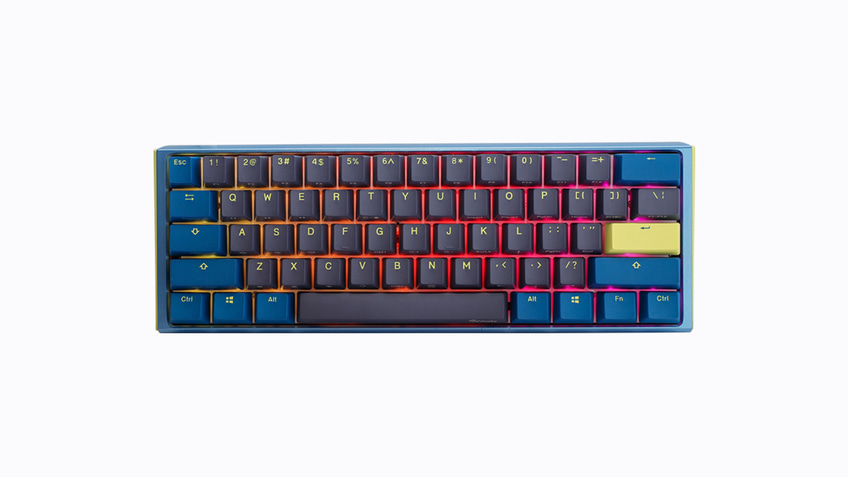


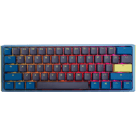


I’ve been wanting a gaming keyboard, so do you think I should get the ducky one 3 mini with speed slivers or the hyper x alloy origins red linner?
The switches you end up getting on your keyboard depend entirely on your personal preference, so I sadly cannot help you with that. The One 3 Mini is a great gaming keyboard though, so if you put some switches in there that you enjoy you’re going to have a good time with it!
I been looking into this all day, ducky one 3 sf vs keychron Q2 (I know they are different, but still so hard do choose between them)
I don’t have any experience with the Keychron though it definitely looks really nice from the specs. Tough choice to make!